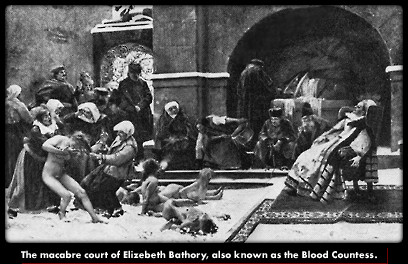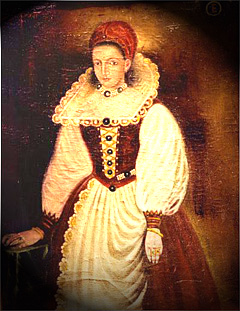 |
Erzsébet Bathory The Hungarian Bloody Countess |

|
It seems the life and deeds of one Hungarian Countess called Erzsébet Bathory are being ignored not to say hushed up. Not too many books and no mentioning of her deeds anywhere. Despite the nature of her evil doings, Hollywood never made a movie about her life. Very much "unlike" Hollywood. One wonders why to this day, this creature's story was never presented to the public at large. Obviously, a Hungarian Countess killing 600+ young girls, could shed a very demeaning light upon Hungary, while Vlad Tepes (a Romanian King) can go on being THE Vampire of the ages with no apparent problems, thus shifting the focus away from the blood thirsty Hungarian Countess and Hungary implicitly. Rumor has it that Bram Stoker's consultant was Hungarian. Any comments?? Please use the following link:Message BoardSupport for the vampire myth could be found historically, extrapolated from a few extraordinary facts. Such was the case of the "Blood Countess." The deeds of a 16th century Hungarian countess named Elizebeth Bathory would rival the tales of horror told in almost any land. Her crimes were evil beyond description, though some say she was more insane than evil. When he was doing research for his novel about vampires, Bram Stoker came across a book called The Book of Werewolves by Rev. Sabine Baring-Gould. (Authors Raymond T. McNally and Radu Florescu suggest that the real-life Dracula -- and yes, there was one -- may have been related to Bathory on his Hungarian side of the family.) In this work was a description of the sinister deeds of the so-called Blood Countess. It is likely that this story, among other things, provided inspiration to Stoker for his vision of Count Dracula. In fact Elizebeth's cousin, Stephan Bathory, would one day become a prince in Transylvania. Elizebeth was a well-educated and clever woman, but she possessed a tremendous cruel streak. Apparently fearing her own mortality after the death of her husband, she became sadistic towards her servants and eventually sought to acquire if not eternal life or longevity, then at least the appearance of youthful skin by washing in blood. Elizebeth actually got tips on how to torture from her husband who, as a soldier, used to brutalize Turkish prisoners-of-war. Bathory reportedly murdered scores of women, sometimes aided in her brutal deeds by her underlings (not unlike the fictional Dracula commanding his own servants to do his evil bidding.) Bathory beat her victims routinely and mutilated them as well. Reportedly she froze some in the snows of winter near her home called Castle Csejthe, dumping ice water on them in freezing weather. There were possible acts of cannibalism as well; allegedly Bathory once took several bites out of the flesh of a living servant girl. And there were legendary tales of the Blood Countess literally bathing in the blood of virgin girls in the hopes of remaining young (although at least one source claims the blood baths are more legend than reality). Nevertheless, it is quite clear that the Hungarian countess Elizebeth Bathory did exist and that she committed evil acts. Another source says she drank the blood of 650 girls who were also murdered.  As the body count grew, Bathory's servants dumped the corpses
outside the castle. When local peasants found the dead bodies,
drained of blood, naturally they assumed vampires killed them.
Rumors spread.
In 1610 she was arrested after her attempts to kill girls of nobler
birth; apparently the grounds for arrest pertained to alleged
witchcraft, not vampirism per se. Reportedly victims were found in
the castle drained of blood. The countess' henchmen were put to
death by the authorities and Elizebeth was imprisoned in her
bedroom in her Castle in the Carpathian Mountains until her death
years later. The only real evidence of Bathory's atrocities were
recalled in her two trials in 1611 -- though she was never allowed to
appear personally in court, only her henchmen appeared. Still, many
myths have continued to flourish about her. It is said that some
people even today claim to see her ghostly vision in her homeland in
the Carpathians, prowling at night... in search of blood.
Elizebeth Bathory's story demonstrates how the myth of vampirism
can be supported by the misinterpretation of the true life actions of a
deranged criminal and feed the ignorance of believers.
As the body count grew, Bathory's servants dumped the corpses
outside the castle. When local peasants found the dead bodies,
drained of blood, naturally they assumed vampires killed them.
Rumors spread.
In 1610 she was arrested after her attempts to kill girls of nobler
birth; apparently the grounds for arrest pertained to alleged
witchcraft, not vampirism per se. Reportedly victims were found in
the castle drained of blood. The countess' henchmen were put to
death by the authorities and Elizebeth was imprisoned in her
bedroom in her Castle in the Carpathian Mountains until her death
years later. The only real evidence of Bathory's atrocities were
recalled in her two trials in 1611 -- though she was never allowed to
appear personally in court, only her henchmen appeared. Still, many
myths have continued to flourish about her. It is said that some
people even today claim to see her ghostly vision in her homeland in
the Carpathians, prowling at night... in search of blood.
Elizebeth Bathory's story demonstrates how the myth of vampirism
can be supported by the misinterpretation of the true life actions of a
deranged criminal and feed the ignorance of believers.
|
 Dracula's Live Radio
Dracula's Live Radio
© Copyright 1997-2025
